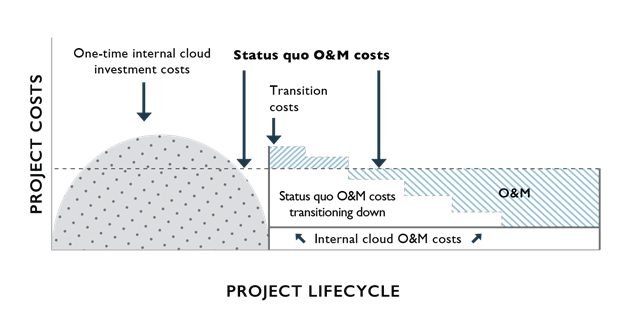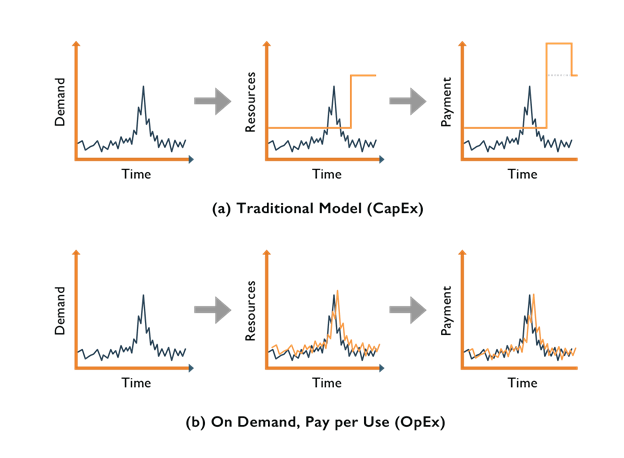Cloud computing is often referred to as a technology or even a commodity. However, it is actually a paradigm shift in the business and economic models for provisioning and consuming information technology that can lead to a significant cost savings. These cost savings can only be realized by significant pooling of these “configurable computing resources” or resource pooling. This capability is an essential characteristic of cloud computing. Resource pooling defines the ability of a cloud to serve multiple consumers using a multitenant model with different physical and virtual resources dynamically assigned and reassigned according to consumer demand.
Economic Impact of the Cloud Computing Model
Businesses must always deal with the disparity between the capacity to produce products and deliver services—which is fixed in the short term—and the demand for those products and service—which is almost always variable at any time scale. Customer demand in just about any circumstance is volatile. While some tactical measures can be taken to alleviate some scenarios, cloud computing models have been shown capable of economically solving the so-called “demand dilemma” when applied to cloud computing–compatible business models.
Cloud computing can economically address the “capacity conundrum” where companies build capacity to match peak demand, which typically leads to substantial excess capacity during off-peak periods. This excess capacity represents either nonproductive capital or unnecessary expense. Conversely, if capacity is sized to the baseline, there will be insufficient resources to handle spikes. Transactions not served represent demand for the products or services that the business would have monetized, resulting in lost revenue or lost worker productivity.
For the cloud service provider, cloud computing economics depends on the expected consumption characteristics of the targeted customer population. These factors drive the cloud provider’s ability to use the minimum amount of physical IT resources to service a maximum level of IT resource demand. Properly balancing these factors across a well- characterized user group can lead to ~30 percent savings in IT resources. This enables the near-real-time modification of the underlying physical infrastructure required for the delivery of the desired “illusion of infinite resources” that is synonymous with a cloud computing user’s experience.
Cloud service providers bring massive economies of scale to computing and deliver computing resources on demand. Before cloud computing, companies had to make ever-growing capital expenditures (CapEx) in computing resources to implement new information systems and to accommodate potential peak loads. This led to overcapacity and underutilization. Cloud computing can help exploit short-term business opportunities, because cloud computing services are consumed using a variable operation expenditure (OpEx) model, which:
- Eliminates long-term investments when exploring new business models
- Is an efficient enabler of cross-device access and synchronization of content or applications across a single user with multiple devices
- Eliminates hardware costs normally associated with new systems or services
This combination drives the information technology industry away from highly customized independent architectures, which generally drive prevailing prices upward. Cloud computing drives the industry towards pooled resources, shared architectures, flat-rate pricing models, and pay-per-use pricing models, which generally lowers prevailing prices.
An early 2009 Booz Allen Hamilton study concluded that a cloud computing approach could save 50–67 percent on the lifecycle cost for a 1,000-server deployment.

A separate Deloitte study confirmed that cloud computing deployments delivered greater investment returns with a shorter payback period when compared to the traditional on-premises option. These studies show that, when implemented properly, the IT service delivery model can drastically reduce the operations and maintenance cost of IT infrastructures. Verification of these findings by many other independent studies, along with the rapid proliferation of billion-dollar “born-in-the-cloud” startups, accelerated the continuing and broad-based rapid growth and adoption of the cloud computing economic model.

Private Cloud Transition Economics
Transitioning from a traditional enterprise IT infrastructure to the private cloud model involves a significant level of investment, operational modifications, and cultural change. Investment is driven by an increased use of automation, staff skillset enhancements, and training costs associated with needed operational changes.
Operational modifications are associated mostly with “brutal” enforcement of standards across the organization. Aggressive enforcement of standards is essential to the broad and deep deployment of automation needed to effect significant staff reductions and effective service-level management.
The significant cultural changes associated with the aforementioned operational modifications should not be underestimated. Cultural changes will permeate the entire organization for five or more years if done across a global organization. Research has also shown that the cost of private cloud deployments may exceed the operating cost of an established traditional operation. Organizations should also be cautioned about the relative rarity of cost savings being associated with a transition to a private cloud. Cost savings are much more likely if a subset of requirements is addressed through a private cloud and the balance appropriately met with the adoption of public or community cloud services. Resulting hybrid cloud models have been shown to significantly reduce operating costs while simultaneously improving operational efficiency.
Public Cloud Adoption Economics
Public cloud adoption has historically delivered significant enterprise IT cost savings through significantly reduced capital expenditures, staff level reductions, and increased operational efficiencies. These well-documented results are driven primarily by the public cloud service provider’s ability to deliver a continuously improving level of service at lower cost and higher profit margins. Consistency in these trends is reinforced by global scale, very low marginal cost to deliver services to additional customers, and steadily improving CSP operational efficiencies.
Cloud Computing Return on Investment
Although business alignment is paramount, cloud computing return on investment (ROI) must also be addressed. This metric should be addressed from multiple vantage points.
Cloud economic savings can be measured through the following key performance indicators (KPIs):
- Workload versus utilization percent
- Workload type allocations
- Instance to asset ratio
- Ecosystem optionality (increased flexibility to choose and change IT providers)
The ROI model can also include operational metrics, such as the speed of cost reduction, optimizing cost of capacity, and optimizing ownership use. Business value can also be gleaned from process time reductions, product quality improvements, and customer experience enhancements.
KPIs should have defined metrics based on either ISO 27004, relevant ISO publications, negotiated service-level agreements, or NIST Special Publication 800-55. Within each ROI domain, targeted values should address one of the following:
- Measures of effectiveness
- Measures of efficiency
- Impact measures